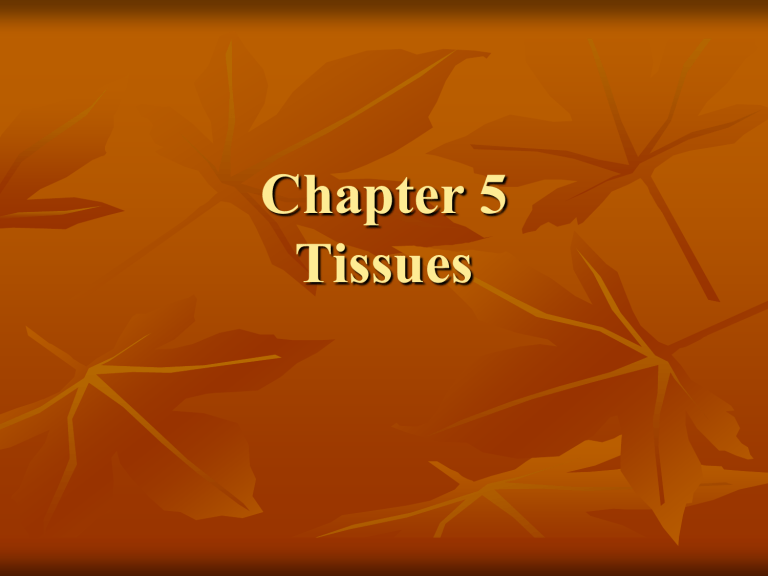Chapter 5 Tissues

Chapter 5
Tissues
How is it all Connected?
Cells = basic unit of life
Cells come together to form TISSUES
TISSUES come together to form ORGANS
ORGANS come together to form SYSTEMS
SYSTEMS come together to form US.
So what is a TISSUE?
“Layers or groups of SIMILAR cells with a
COMMON function.”
Tissues are distinguished from each other because of differences in size, organization, and function
Can you think of anything that would be considered a TISSUE?
BLOOD
MUSCULE TISSUE
SMOOTH TISSUE
SMOOTH TISSUE
BONE
CARTILAGE
NERVOUS TISSUE
4 TYPES OF TISSUES
Epithelial Tissues:
Covers the body’s surface and organs.
Connective Tissues:
Tendons, ligaments, cartilage, blood, fat, bone
Muscle Tissues:
Skeletal Muscles, heart, smooth muscle
Nervous Tissues:
Brain, spinal cord, nerves
EPITHELIAL TISSUES
So if Epithelial tissues are on the body surface and surround the organs, then what do you think this type of tissue’s function is?
Protection: Example?
Secretion: Example?
Absorption: Example?
Excretion: Example?
EPITHELIAL TISSUES
Where are they located?
Surface of the body
Cover the internal organs
Compose the glands
Distinguishing Characteristics?
No blood vessels. Why do you think?
Cells divide rapidly. Why is this good?
Cells are tightly packed. How does this help us?
EPITHELIAL TISSUES
Epithelial Tissues are classified by the shape of their cells.
There are 3 different epithelial tissue cell types
1. Squamous : flattened cells
2. Cuboidal : Cube-like cells
3. Columnar : Elongated
EPITHELIAL TISSUES
The arrangement of these cells varies.
There are two different ways to arrange
Epithelial Tissues
1.
Simple : one layer of cells.
2. Stratified : two or more layers of cells.
Types of Epithelial Tissues
There are eight different types of Epithelial tissues.
When you refer to one type of Epithelial tissue you call it an Epithelium (this is the singular spelling).
Example: Simple Squamous Epithelium
What can you tell me about the name above based on what you just learned?
Connective Tissues
**Comprise much of the body
**The most abundant type of tissue by weight.
1. bind structures
2. provide support and protection
3. serve as a framework
4. fill spaces
5. store fat
6. produce blood cells
7. protect against infection
8. help repair tissue damage.
Major Connective Tissue Cell
TYPES
1. Fixed cells: reside in the tissue for extended period of time
Example: fibroblast = large star shaped p.152
2. Wandering Cells: appear in tissues temporarily in response to injury or infection.
Example: Mast cells = release histamine that dialates capillaries = swelling and redness.
Categories of Connective Tissue
1. Loose Connective Tissue: binds the skin to the muscle tissue below
2. Adipose Tissue: = fat
These cells accumulate fat, they enlarge and their nuclei is pushed to one side
When they become too abundant they crowd out other cell types and form “adipose tissue”
Found: between muscles, around kidneys, behind eyeballs, surface of the heart, and around joints.
Adipose tissue
3. Reticular connective tissue: provides the framework for some internal organs (spleen, liver, lymphatic organs.
They have collagen
fibers
4. Dense Connective Tissue: tendons and ligaments
Very strong and can withstand pulling forces.
Binds body parts together
Has poor blood supply and is very slow to heal.
This is why sprains, damage to tissue around joints, takes considerable time to heal.
P.158
Dense Connective Tissue
5. Elastic Connective Tissue: found in the attachments between bones of the spinal column.
Very rare in the body but are found in large arteries such as the aorta.
http://www.austincc.edu/histologyhelp/tissues/t n_elas_ct.html
6. Cartilage: rigid, provides support, framework, attachments, provides a structural model for many developing bones.
Contains a large volume of water
Lacks a direct blood supply, blood vessels surround it, obtain nutrients by diffusion
This is why torn cartilage heals so slowly
3 types of cartilage
1. Hyaline: most common, tips of bones at joints, soft part of the nose, supporting rings of the trachea. Prominent in early development.
2. Elastic: more flexible, ears and larynx
3. Fibrocartilage: very tough, shock absorber, intervertebral discs, knees and pelvis.
7. Bone:
Most rigid connective tissue
Internally supports body structures
Very active tissue
Heals much more rapidly than injured cartilage because of close access to a blood supply
8. Blood
Cells suspended in fluid called PLASMA
1. Red blood cells: transport gases
2. White blood cells: fight infection
3. Platelets: cause blood clotting
Where do blood cells form?






